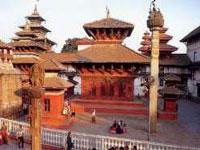Airport
Tribhuvan International Airport
IATA Code: KTMLocation: The airport is situated four miles (6km) east of Kathmandu.
Time: GMT +5.45.
Contacts: Tel: +977 (0)1 470 274.
Transfer between terminals: The small international and domestic terminals are located within easy walking distance of one another.
Transfer to the city: A pre-paid taxi service operates from immediately outside the arrival gate. Rates are exhibited on a board and the fare must be paid in advance. Local buses also serve the airport, the journey is 35 minutes and costs Rs40.
Taxis: Both pre-paid taxis and normal taxis are available at the airport. Pre-paid taxis are often more expensive than regular taxis hailed outside the airport. Taxi drivers often try to overcharge passengers, so only pay when you are at your destination and agree on a price before getting into the vehicle. Fares into the city are generally NPR 250 during the day and a NPR 50 surcharge at night.
Car rental: Car rental companies are represented.
Facilities: Facilities include banks and bureau de change, shops, duty-free, snacks, Internet, post office and tourist information. The airport is well equipped with facilities for those with disabilities.
Parking:
Departure tax: NPR 1,130 (international), NPR 169.50 (domestic).
Website: www.tiairport.com.np
Visit worldtravels.com for the full guide to Kathmandu. Build a complete Kathmandu travel guide and email to your clients - sign up for a trial subscription of World Travels Pro.
Kathmandu

Presided over by snow-covered mountains, the Kathmandu Valley is surrounded by verdant agricultural hills scattered with traditional villages and brick houses, rich in ancient holy temples and shrines used by both Buddhists and Hindu worshippers reflecting a great wealth of culture and tradition. Most of Nepal's ethnic groups are represented in the Valley, particularly in Kathmandu itself, but it is the Newars who are the original inhabitants responsible for development and the splendid art and architecture in the cities.
The Valley is the cultural, political and commercial centre of Nepal and encompasses three cities: Kathmandu the capital; Patan, which has been enveloped by the growing Kathmandu outskirts; and the medieval city of Bhaktapur. For the unprepared visitor, the capital city of Kathmandu can trigger a sensory overload - it is a heaving city of both intriguing and unpleasant smells, incessant noise and pollution, and sights that etch themselves on the memory. Cows wander the streets of the old city, stepping between steaming piles of rubbish and hooting taxis, and narrow alleyways overflow with spices, vegetables and handicraft shops. Throngs of people thread their way along bustling cobblestone streets lined with structures from an ancient architectural heritage, which lead onto open squares surrounded by temples of all shapes and sizes. The largest city in Nepal and the nation's historical centre, Kathmandu throws together a blend of the country's varied population and boasts a distinctive, age-old religious influence visible in the daily life of its inhabitants.
Fascinating as this city is however, many people choose to stay outside Kathmandu in one of the Valley towns or mountain resorts and restrict their visit to day trips; or they base themselves in the tourist-orientated Thamel district of the city that offers modern bakeries, smart hotels and upmarket restaurants, along with pushy handicraft and cannabis sellers.







